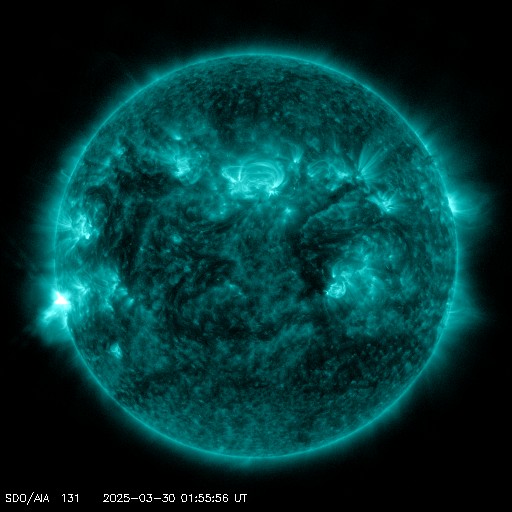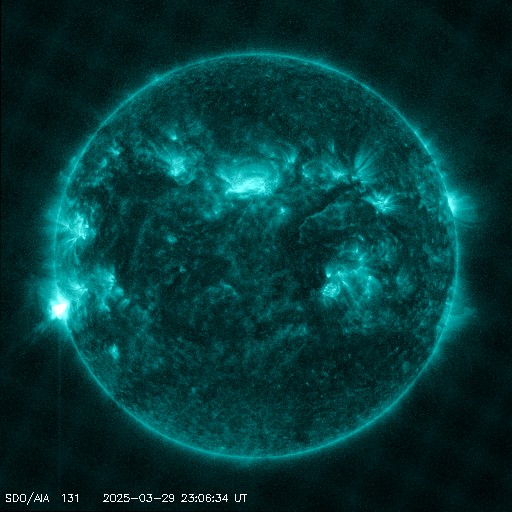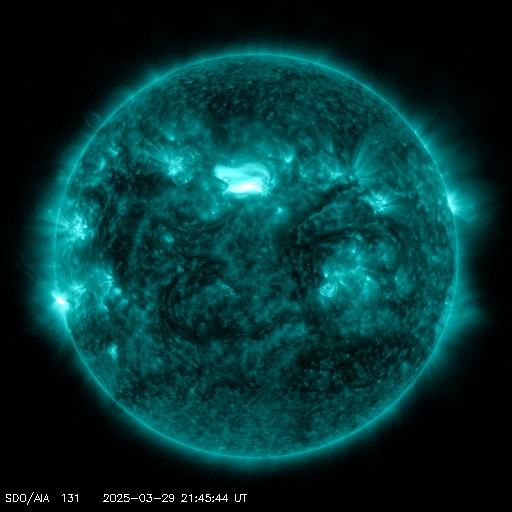Viewing archive of Tuesday, 6 April 2010
Solar activity report
Any mentioned solar flare in this report has a scaling factor applied by the Space Weather Prediction Center (SWPC). Because of the SWPC scaling factor, solar flares are reported as 42% smaller than for the science quality data. The scaling factor has been removed from our archived solar flare data to reflect the true physical units.
Report of Solar-Geophysical Activity 2010 Apr 06 2201 UTCPrepared by the NOAA © SWPC and processed by SpaceWeatherLive.com
Joint USAF/NOAA Report of Solar and Geophysical Activity
SDF Number 096 Issued at 2200Z on 06 Apr 2010IA. Analysis of Solar Active Regions and Activity from 05-2100Z to 06-2100Z
Solar activity was very low. Todays flare activity
consisted of a single B1 X-ray event at 0402Z from Region 1060
(N26E32). In addition a small, possibly earthward directed CME was
observed in the Stereo coronagraph images and was associated with
disk activity in the SOHO EIT images beginning at about 0113Z, just
north of Region 1061 (N14W24). Region 1061 appears to be growing
slowly.
IB. Solar Activity Forecast
Solar activity is expected to be very
low, but there is a chance for an isolated C-class event from Region
1061.
IIA. Geophysical Activity Summary 05-2100Z to 06-2100Z
The geomagnetic field was at active to minor storm levels for most of
the day, with the exception of an interval of minor to major storm
levels between 0000-0600Z. Solar wind observations from the ACE
spacecraft showed a slow trend of increasingly negative Bz
consistent with continued influence of yesterdays CME-driven
activity. Peak negative Bz values reached -8 nT at about 1250Z.
Solar wind velocity gradually decreased during the past 24 hours and
was about 550 km/s at the end of the period. The greater than 2 MeV
electron flux at geosynchronous orbit reached very high levels
during the past 24 hours.
IIB. Geophysical Activity Forecast
The geomagnetic field is
expected to be active for the first day (07 April) due to a
favorably positioned coronal hole. Activity levels are expected to
be unsettled to active on the second day (08 April) due to
persistence as well as possible effects from todays CME.
Predominantly quiet levels are expected on the third day (09 April).
III. Event Probabilities 07 Apr to 09 Apr
| Class M | 01% | 01% | 01% |
| Class X | 01% | 01% | 01% |
| Proton | 01% | 01% | 01% |
| PCAF | green | ||
IV. Penticton 10.7 cm Flux
Observed 06 Apr 078 Predicted 07 Apr-09 Apr 082/085/085 90 Day Mean 06 Apr 083
V. Geomagnetic A Indices
Observed Afr/Ap 05 Apr 028/049 Estimated Afr/Ap 06 Apr 025/030 Predicted Afr/Ap 07 Apr-09 Apr 015/020-012/015-005/007
VI. Geomagnetic Activity Probabilities 07 Apr to 09 Apr
| A. Middle Latitudes | |||
|---|---|---|---|
| Active | 40% | 20% | 05% |
| Minor storm | 20% | 10% | 01% |
| Major-severe storm | 05% | 01% | 01% |
| B. High Latitudes | |||
|---|---|---|---|
| Active | 45% | 25% | 05% |
| Minor storm | 25% | 15% | 01% |
| Major-severe storm | 10% | 05% | 01% |
All times in UTC
Current data suggests there is a slight possibility for aurora to appear at the following high latitude regions in the near future
Gillam, MB, Yellowknife, NTFairbanks, AK
Latest news
Latest forum messages
AR4046 129AR4048 20AR4043 47Incoming & Unnumbered Active Regions 1658Aurora photography hints for those of us with smartphones 51
More topicsSupport SpaceWeatherLive.com!
A lot of people come to SpaceWeatherLive to follow the Sun's activity or if there is aurora to be seen, but with more traffic comes higher server costs. Consider a donation if you enjoy SpaceWeatherLive so we can keep the website online!

Latest alerts
02:09 UTC - Solar flare
Moderate M1.54 flare from sunspot region 4048
01:42 UTC - Radio Blackout
Minor R1 radio blackout in progress (≥M1 - current: M1.24)
Saturday, 29 March 2025
23:21 UTC - Solar flare
Moderate M1.91 flare from sunspot region 4048
22:51 UTC - Radio Blackout
Minor R1 radio blackout in progress (≥M1 - current: M1.1)
21:57 UTC - Solar flare
Moderate M1.45 flare from sunspot region 4048
Space weather facts
| Last X-flare | 2025/03/28 | X1.1 |
| Last M-flare | 2025/03/30 | M1.5 |
| Last geomagnetic storm | 2025/03/27 | Kp5 (G1) |
| Spotless days | |
|---|---|
| Last spotless day | 2022/06/08 |
| Monthly mean Sunspot Number | |
|---|---|
| February 2025 | 154.6 +17.6 |
| March 2025 | 127.5 -27.1 |
| Last 30 days | 127.5 -24.7 |





